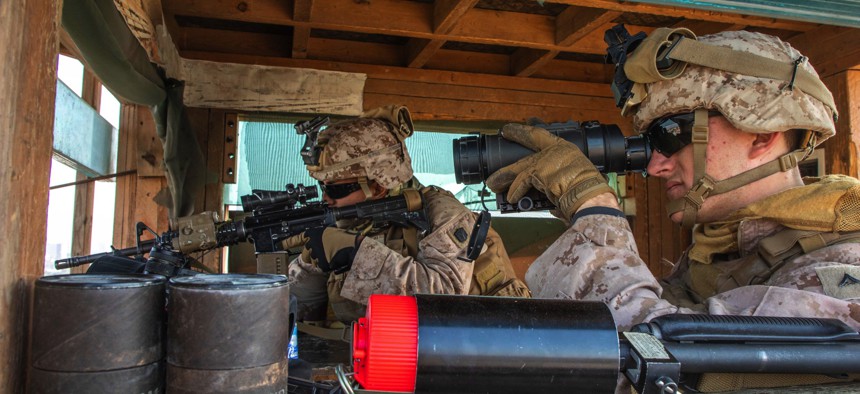
U.S. Marines provide security at the U.S. Embassy compound in Baghdad, Jan. 3, 2020. Marine Corps Sgt. Kyle Talbot
Soleimani Strike Could Imperil US Troops In Iraq
Trump and his allies have sought to frame Iraq’s response to the strikes as a choice between Tehran and Washington, but the situation is not so black-and-white for Baghdad.
The Jan. 2 drone strike that killed a top Iranian general may have jeopardized America’s military presence in Iraq, pushed the U.S. and Iran closer to war, and may yet force a retrenchment across the Middle East, security analysts, lawmakers and former officials warn.
The Iraqi Parliament for months has toyed with a measure that would eject the remaining U.S. troops, who are currently in Iraq at the invitation of the government to fight ISIS. The Thursday killing of Soleimani and Abu Mahdi al-Muhandis, a prominent Iraqi militant — via an airstrike at the Baghdad airport — has thrown gasoline on the blaze of nationalism and Iranian influence that was already threatening America’s status in Iraq.
Trump and his allies have sought to frame Iraq’s response to the strikes as a choice between Tehran and Washington, but the situation is not so black-and-white for Iraqis. Iraq and Iran share a border, a Shia majority and a common enemy in ISIS. Both Iran and the United States have been involved in the formation of Iraqi governments since the 2001 invasion under President George W. Bush.
“Remember [Soleimani] was the first to come to help us fight ISIS; without him Baghdad and Erbil might have fallen,” said one senior Iraqi official.
The United States has about 5,200 troops in Iraq, to fight the remnants of ISIS in-country and in next-door Syria. A senior defense official told reporters on Friday that the Pentagon is “actively engaged” with Iraqi officials to ensure those troops can continue their mission.
So far, Trump administration officials have been able to persuade Iraqi lawmakers not to take the vote on troop presence, in part because even Iran-aligned elements of Iraqi’s governing class recognize the value that American troops and money bring to the fight against ISIS.
But Thursday’s strike was instantly condemned by rival Shiite political leaders in Iraq, including the U.S.-backed Prime Minister Adel Abdul Mahdi, who called it an “assassination by U.S. forces of Iraqi and Iranian figures who were symbols of the victory against Daesh.” The State Department on Friday urged Americans to leave Iraq immediately.
Now, close Iraq watchers are split over whether the killing of Soleimani on Iraqi soil will push the Parliament to push out U.S. troops.
“I think that’s very, very likely,” Kirsten Fontenrose, a former top Middle East policy official on President Donald Trump’s National Security Council, said of a vote ejecting U.S. troops. “The only thing that would hold that back is the chaos in trying to hold the Parliament together for a vote.”
Charles Lister, a senior fellow at the Middle East Institute, said on Twitter that the U.S. “will have to leave Syria soon and the Iraq presence is likely on its way out too.”
Michael Knights, a senior fellow at The Washington Institute who specializes in the military and security affairs of Iraq, argued that there are too many Iraqi politicians who have staked their futures with the Americans, in part as a way to counterbalance Iranian influence in the country. Those officials, he said, “want us there for their own reasons.”
“That’s why after three crises of eviction already last year, it never progressed. This one is more serious, but I still reckon we’ll find a way out of this,” he said. “There’s so many ways to delay a piece of law in Iraq that I have a feeling we’ll get away with this.”
Who wins in Iraq?
Still, Knights said, Iraqi nationalists who want to see the United States gone will likely be strengthened politically by the drone strikes.
Iraqis share a sense of national identity unique to the region and are loathe to see their country become a battleground for a proxy war between Iran and the United States. Thousands have taken to the streets in recent months to protest Iranian influence in the country’s politics, amid broader demands related to government corruption. But backlash also still simmers from February remarks by Trump that U.S. troops in Iraq are there to “watch Iran.”
Knights said the “primary beneficiary” of the strikes is the nationalist cleric Moqtada al-Sadr, who has called on Parliament in the past “to issue a decision to get the American forces out of Iraq.” (Sadr’s bloc won the largest share of parliamentary votes in May.)
Public reaction to the drone strikes could strengthen Sadr’s hand enough to place additional restrictions on American forces operating in Iraq, Knights said — even though Sadr likely isn’t mourning Soleimani’s death.
“If you’re Sadr, you’re probably having a sneaky giggle about this,” Knights said. “A lot of [Iraqis] don’t care about this—in fact, they’re quite happy about it… But they have to look really sad.”
What about Iran?
The uncertain future of the U.S. presence in Iraq comes as officials are poised for retaliation for the drone strikes and some analysts are warning that a broader war could be imminent. The United States is sending as many as 4,000 additional troops to the region in response to the threat.
"We took action last night to stop a war. We did not take action to start a war,” Trump said in remarks at his Mar-a-Lago estate in Florida on Friday afternoon.
The strike on Soleimani capped weeks of escalating tensions between Iran and the United States.
A U.S. contractor was killed in a rocket attack on an Iraqi airbase near Kirkuk on Dec. 27, and the Pentagon retaliated days later with airstrikes on five Iran-aligned militias in Iraq and Syria. Iran-aligned protesters then stormed an outer area of the U.S. embassy compound in Baghdad while Trump and Iran’s Supreme Leader traded barbs on Twitter. The strike on Soleimani, the Pentagon said in an unattributed statement, “was aimed at deterring future Iranian attack plans.” According to Secretary of State Mike Pompeo, the U.S. had intelligence showing an “imminent” threat to Americans in the region.
“Iran was pushing for a broader conflict short of all out war,” a U.S. official who was briefed on the intelligence regarding Soleimani’s alleged threats the day before the strike, told Defense One. "The strike on Soleimani was aimed at nipping that escalation in the bud by taking out the guy doing the tactical planning, and simultaneously sending a signal that we would react very, very strongly.”
Iran has vowed “severe revenge” even as analysts in the United States have largely split along party lines as to whether Trump’s decision to strike Soleimani — a move that previous administrations had considered but ultimately rejected for a number of reasons — will spark a broader conflagration. On Friday afternoon, the long-term implications of the death of one of the most powerful men in the Middle East remained difficult to predict.
“There are unknown consequences for force protection, partnerships, regional security and both our strategy against Iran and the National Defense Strategy,” said Joseph Votel, who retired last year as head of U.S. Central Command. “The region, if possible, has just become more complicated.”





